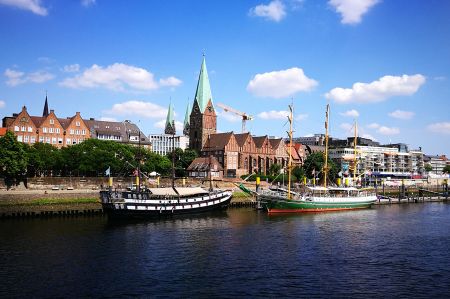Bremen - Hike along Weser to the historical market square
- Written by Portal Editor
Despite sometimes dark, but quickly passing clouds, we used the next day for a lengthy walk along the Weser River before it was to cross the bridge on the way to the market square and the dome of Bremen.
Even the walk along the Weser River can be expected as an exhibit of the long history of the city, since single ships on the river point to the historical epochs, as there are paddle steamers, various excursion boats of the past centuries as well as traditional Sailing ships, one being used as museum ship and as restaurant.
Between the 1st and the 8th century AD, the first settlements were built on the long dune along the river, which protected the settlements from floodwaters of the Weser River and offered good access to a path / ford through the Weser. For visitor from inside the country it might be good to explain, that the tide from the North Sea reaches up to Bremen. Floods on the North Sea leave their marks in Bremen and on the Weser River too. But now we turn back to history.
As early as 150 AD, the Alexandrian geographer Claudius Ptolemaeus mentioned one of these settlements on the long dune, which was then called Fabiranum, another written form was Phabiranum.
As a bishop's town and a merchant settlement, Bremen's history dates back to the eighth century. However, it was still a relatively uncertain area for missions. Thus the missionary Willehad wrote in the year 782: "... we were driven out of Bremen and two priests were slain." The city later on was raised to Bishop's seat in 787 by Charles the Great. Since 845 Archbishop Adalbert of Bremen (1043-1072) could put his influence on a bigger area.
In 1260, Bremen joined the Hanseatic League, but the town was an unsafe coalition partner. Free trade, which was associated with the membership in the Hanse Association, was a flourishing event at those days, and this is still evident today. The city, which was increasingly important in economic terms, partly shook the ecclesiastical rule of the bishopric of Bremen and, as a sign of its secular freedom, built the well-known Bremen Roland (1404) and its town hall (1409) on the market square of Bremen.
The fortified Neustadt was built on the west bank of the river Weser to protect the Weser harbor between 1574 and 1590. The Weser, however, was increasingly despoiled, and it was becoming increasingly difficult for the merchant ships to use the battalion, which had been used since the 13th century as a seaport. From 1619 to 1623 Dutch constructors built the first artificial harbor of Germany in the river at Vegesack.
The Roland is the center and a landmark of the city. Roland's original head is exhibited in the Focke Museum. During the Second World War it was replaced by a copy cause of fear of destruction by bomb attacks. Its view is directed towards the St. Peter's Cathedral, which provides visitors with the Cathedral Museum and the lead cellar. Next to the Roland stands the fascinating town hall, in its Ratskeller wine is served and sold. The so called famous Bremen city musicians, also a landmark of the city, can be found on the west wall of the town hall. Here the German fairy tale road ends. It is followed by the former Council Church of Our Lady.
In connection with the old town hall there is the New Town Hall, built according to the plans of Gabriel von Seidl in neo-Renaissance style and inaugurated in 1913. This is where the Senate Chancellery, the Bremen government center, is located.
On the opposite side of the market square you will find the Schütting, the house of the merchants. The east side of the square is occupied by building of the citizens of Bremen, on the west side there is a series of four buildings from the 18th and 19th centuries. Between the Schütting and the Bremer Baumwollbörse there is the entry to Böttcherstraße, a total art work created between 1922 and 1931. Following the path, you will reach Martinikirche on the river.
From the time of the Weser renaissance, a number of buildings have been preserved in Bremen, too. The town hall (Gothic building) from 1612 and the Schütting from 1538 - both on the market square, the Stadtwaage from 1587 and the Essighaus from 1618 - both in the Langenstraße - and the commercial building at the Ansgarii church yard from 1620.
The walk into the inner city area of Bremen can be enjoyed even without the historical background, because only the terraces along the Weser you will find lot of cafes and pubs for the interim stay.
Please read as well:
The Bremer House - attractive and sought-after living space
The Schnoor - Bremens most attractive visitor magnet
La Strada - Bremen´s city is transformed into a stage
-
-
-
-
-
-
-
-
-
-
-
-
https://www.alaturka.info/en/germany/hanseatic-bremen/3933-bremen-hike-along-weser-river-to-the-historical-market-square/amp#sigProId3f5f047538
